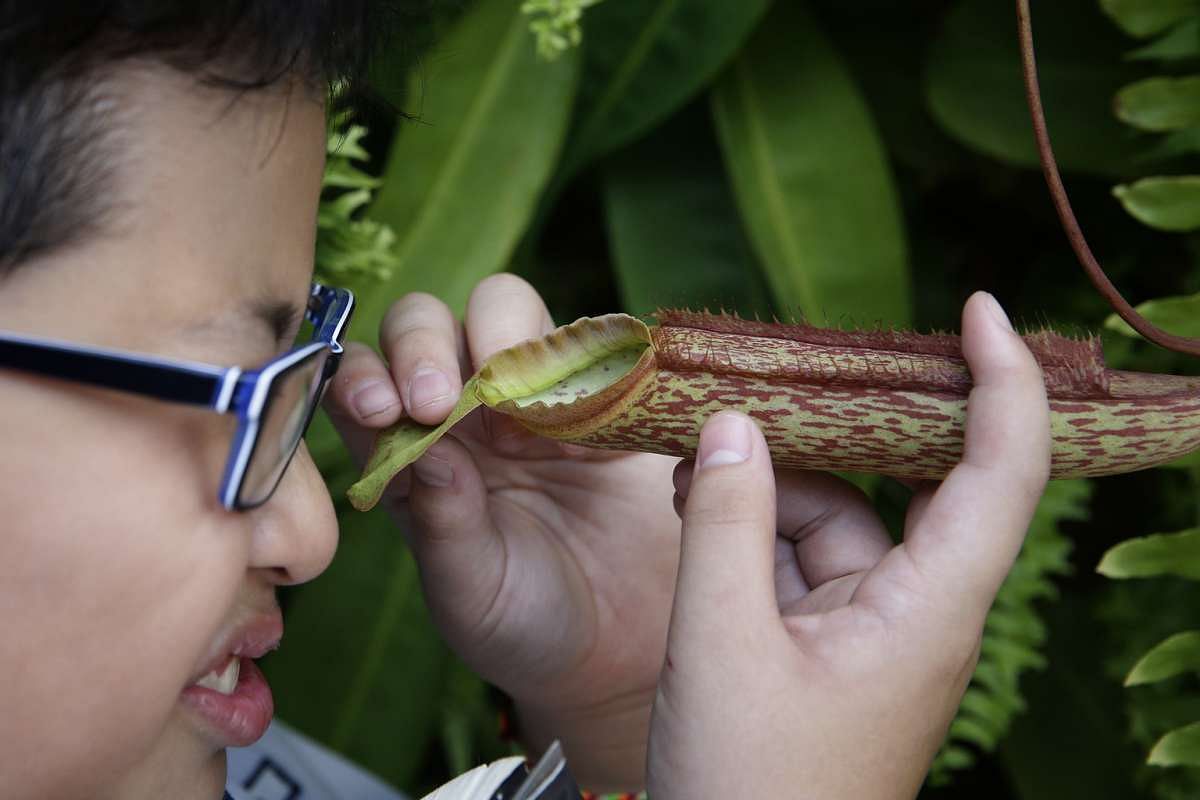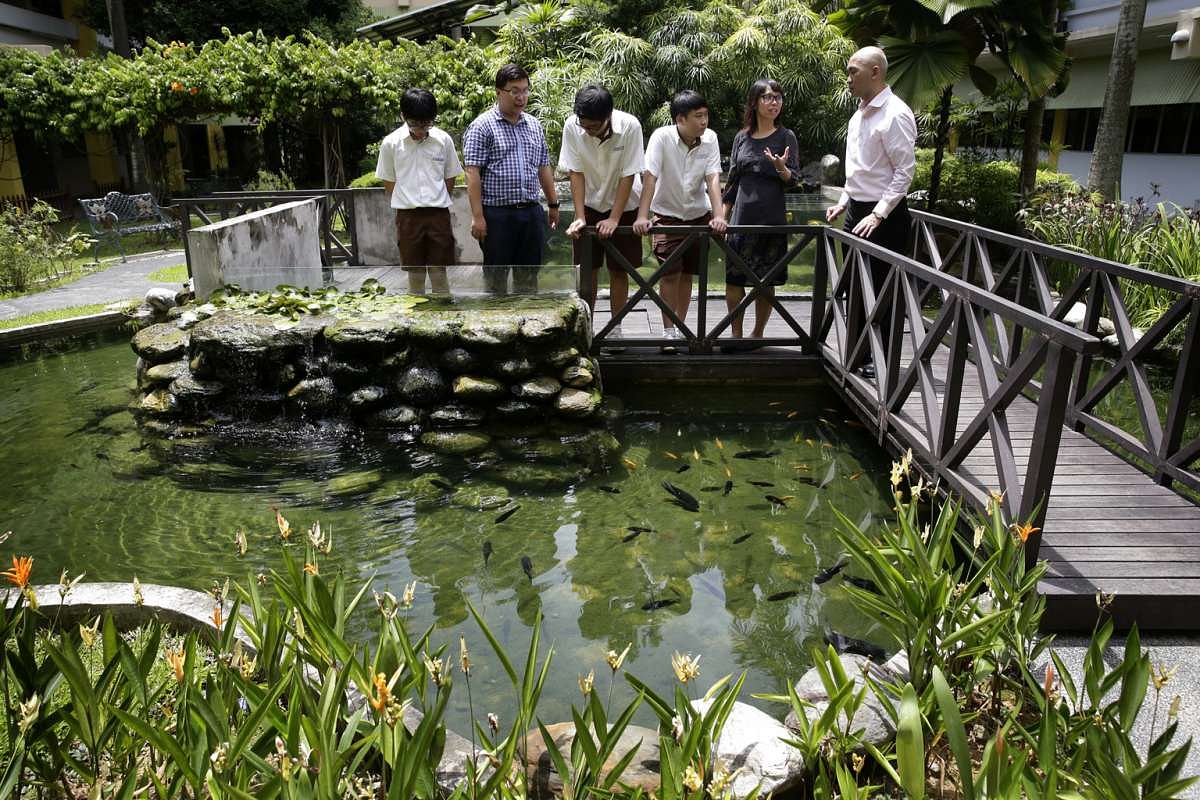At Bukit View Secondary in Bukit Batok, a lot is done with very little.
A fish pond surrounded by four school blocks cleans itself, with plants such as pandan, water lily and lotus acting as natural filters by "eating up" and absorbing decomposing leaves and fish faeces.
Another pond, with a man-made filtration system, is powered partially by two solar panels. A meter tracks the amount of energy used.
An overhanging pipe collects rainwater from the roof of a school block and channels it to a tank that is used to refill both the ponds, conserving water.
One of the ponds even has a water wheel to turn the kinetic energy in flowing water into hydroelectric energy, which is then used to power LED lights.
The eco-garden was created by the school's science department in 2008 as "an outdoor classroom for our students", says Mr Heng Chong Yong, 41, the school's head of department (partnerships).
It was set up back then to complement an environmental module run for its Secondary 1 and 2 students to "show them how energy and water conservation as well as biodiversity of a fish pond actually works", he says, adding that school textbooks can do only so much.
That particular module has since been replaced by another, but the garden continues to play a huge role in clean energy and environmental technology lessons. It also helps the school to distinguish itself from others, says Mr Heng.
But all this was not done without help. The garden cost $77,000 to set up - $50,000 from the Ministry of Education's (MOE) upgrading of facilities fund and the rest donated by the School Advisory Committee, comprising parents, alumni and other members of the public appointed by MOE.
A garden with seven species of plants that can attract butterflies was added in 2014 to boost the school's biodiversity - this was part of the National Parks Board's Greening Schools for Biodiversity programme.
Last year, the school also dipped into its pocket to build a $15,000 pavilion for teachers to conduct classes outdoors. Last month, it started piping nutrients from fish waste from one of the ponds to pots of kangkong in the pavilion to fertilise the vegetables.
The garden, about the size of three basketball courts, also hosts learning journeys for primary school pupils from nearby schools - two to three visits each year - with Bukit View Secondary teachers pitching in with worksheets for them.
The eco-trails, which expand on topics such as food chains and habitats, are led by the school's environmental club, although anyone interested can volunteer to lead as well.
In the future, the school hopes, through assembly talks and forums, to get more students to appreciate nature and the environment. Mr Heng says: "So far, students enjoy going to the garden to relax and chit-chat, but not that many appreciate the natural beauty around them."
But there is at least one unintended benefit of the programme so far. Secondary 2 student Calvert Choo, 13, from the environmental club, says that leading the eco-trails has made him more confident. He says: "I used to be very shy and found strangers scary. But now, I am not afraid to speak in front of people."
Nature stop for the stars
 Commonwealth Secondary School's biology teacher Jacob Tan (above, in printed top) showing students water lettuce in The Wetland eco-habitat; and the Indoor Garden. ST PHOTO: KEVIN LIM
Commonwealth Secondary School's biology teacher Jacob Tan (above, in printed top) showing students water lettuce in The Wetland eco-habitat; and the Indoor Garden. ST PHOTO: KEVIN LIM
Take a walk through the "rainforest" at Commonwealth Secondary School and you would be forgiven for thinking that you are in a real one: The area between two school blocks is filled with shrubs and trees, some of which are two storeys high.
The plot, about the size of three basketball courts, is one of four eco- habitats in the school in West Coast Road. The others are a wetland, an oasis of cattails and mangrove trees which attracts birds such as kingfishers, a freshwater stream with fishes and plants, and a marine reef tank with soft corals and clownfish.
Indeed, the school is so lush that it has attracted other creatures such as monitor lizards and squirrels.
Environmental education in the school started in 2001 when a group of students and teachers, who were nature lovers, formed the Eco Club to run programmes for the school.
In 2013, teachers wanted to create habitats so the whole school could benefit. The following year, it joined the National Parks Board's Greening Schools for Biodiversity programme.
Biology teacher Jacob Tan, 31, who is also the teacher in charge of the Eco Club, says: "The eco-habitats provide students with real ecosystems to study and observe how organisms depend on one another for survival."
The heavy-lifting, such as digging works for the wetland, was done mostly by landscape companies; students were involved in other ways.
In 2014, the club hosted American actors Andrew Garfield and Jamie Foxx, who stopped by as part of the World Wide Fund For Nature in Singapore's Earth Hour events.
But the eco-habitats' impact is much more far-reaching. All academic departments have designated at least one lesson a semester that draws on the eco-habitats and requires students to visit them - a move that benefits the school's 1,300 students.
During mathematics lessons, for instance, students learn to use the growth patterns of tree branches to explore the Fibonacci sequence, a series where a number is found by adding the two numbers before it. In chemistry class, flowers gathered from the eco-habitats are mashed up to produce a mixture that demonstrates chromatography.
Students have grown so attached to the green spaces that when the wetland was invaded by golden apple snails in November last year, they chipped in during breaks and after school to help remove them - by wading through water and using tongs to pick out hundreds of snails and scraping their eggs off leaves.
The snails ate up the water plants and threatened to displace the native freshwater snails. The students' efforts paid off after five months when the population of golden apple snails was brought under control.
Denise Quek, 15, vice-president of outreach at the Eco Club, loves the green spaces, having had little chance to interact with nature as an HDB dweller. "Thanks to the many plants and animals I encountered in school, I can now put a name to the birds and butterflies I see outside."
Mr Tan, who has been a teacher at the school for more than six years, says: "Students today lack interaction with nature. Since they spend most time in school, it would be good if they can encounter nature in school and not wait until they go to the nature reserve. It is only when students feel connected to nature that advocacy and activism will emerge naturally. Without this connection, there's no point talking about global warming and related issues."





 Commonwealth Secondary School's biology teacher Jacob Tan (above, in printed top) showing students water lettuce in The Wetland eco-habitat; and the Indoor Garden. ST PHOTO: KEVIN LIM
Commonwealth Secondary School's biology teacher Jacob Tan (above, in printed top) showing students water lettuce in The Wetland eco-habitat; and the Indoor Garden. ST PHOTO: KEVIN LIM 